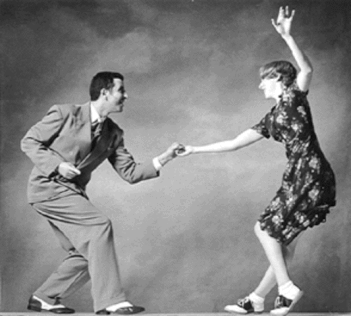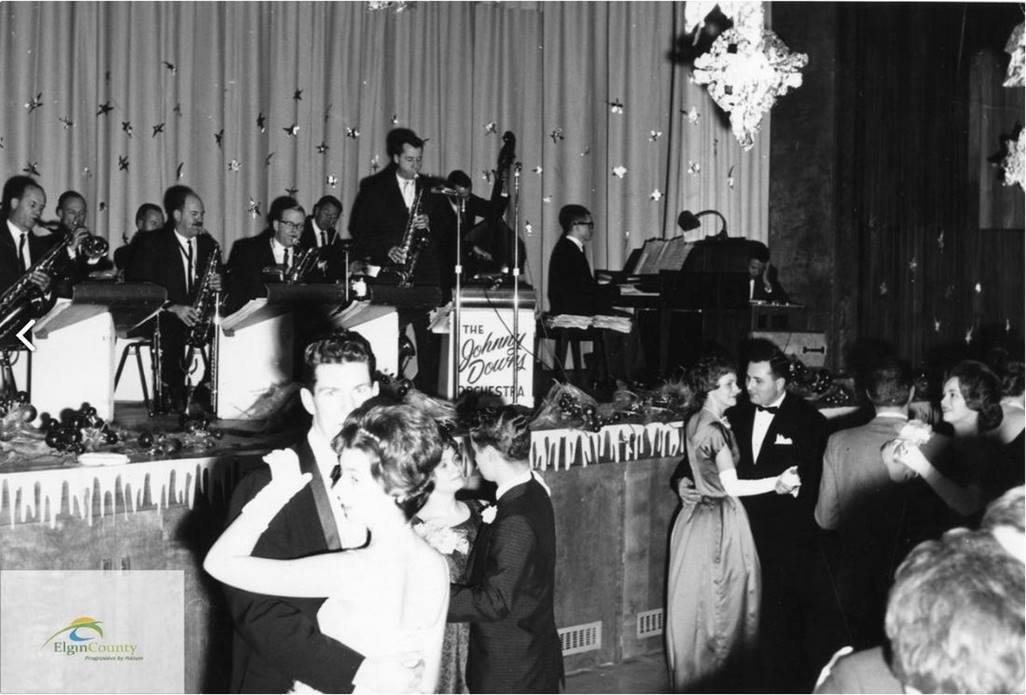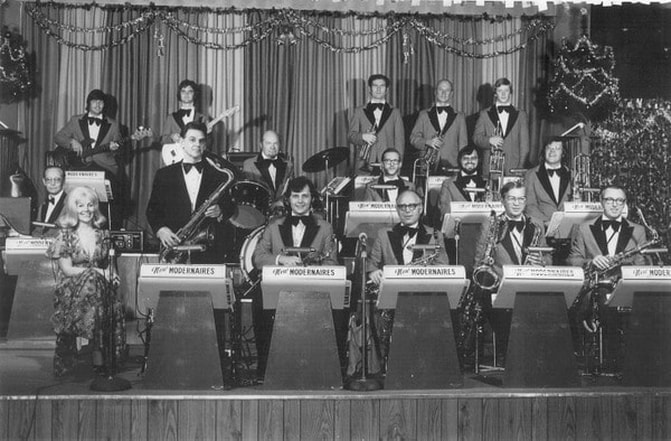 LONDON, ONTARIO – Except for thirty seconds one evening in the winter of 1973, I’ve never really been much of a dancer. Not only is this an incapacity which I have come to regret, I recognize it as something I share with the vast majority of my peers. It’s a bit of a paradox but the rock music we grew up with – arguably the most physically agitating music ever played by Western man – didn’t generate much in the way of great dancing. Certainly there were individual performers who developed a reputation for their dazzling moves but most rock concerts were just that – concerts. Up until the 1950s, few popular musicians gave concerts – not even the biggest headlining acts - without provision being made for their audience to dance. Like most of my boomer cohorts, I sort of knew how to vaguely simulate dance-like motions in a couple of different ways. If the music being performed had an invigorating rhythm, then you didn’t even strictly require a partner. Alone or in company, you just wandered out into the middle of the high school gym until you found some clear space (about ten square feet was good) and commenced gyrating and bopping about until the tune’s conclusion. For a slower tune with a less compelling rhythm, a partner was advisable with whom you would assume a limited and formalized embrace that allowed you to prop each other up and wait for some inertial motivation to shift you this way or that like a four-legged marker on a Ouija board. This latter form was appealing in so far as it gave you a socially acceptable opportunity to be in close proximity to a girl but I never believed that the untrained and uncoordinated movements we undertook were the sort of thing that was portended in grand phrases like ‘the ecstasy of dance’. My parents knew that ecstasy and at least once a month would commend me and my three older brothers to the care of a babysitter (or, later, to the tyranny of each other) while they went out for an evening of dancing to big band music at various venues; as often as not, Port Stanley’s Stork Club. I remember one summer in my teens, I was staying down there at a friend’s cottage for a few days and was about to hitch-hike back to London when I saw that Woody Herman was playing a gig at the Stork Club. Well, I knew my parents would be in there dancing the night away, readily found their car in the jam-packed parking lot and clambered up onto their hood to read my book until they came out and we traveled home together.  The Johnny Downs Orchestra on the bandstand of the Stork Club The Johnny Downs Orchestra on the bandstand of the Stork Club I caught my own thirty-second glimpse of the ecstasy of dance at the age of 21 while going out with a woman who wasn’t big on just hanging out but liked our dates to be built around specific and – by my lights – rather surreal events. At her instigation I attended my first and last wrestling match at the old London Arena. Of course she didn’t take that most dubious of sports seriously but adored the tacky spectacle of it all. Throughout her high school years she followed the cartoonish progress of such beefy showmen as Haystack Calhoun, Whipper Billy Watson, Sweet Daddy Siki and The Sheik and cherished a framed photograph of herself shaking hands with the six and a half foot-tall and ascot-bedecked wrestling commentator, Lord Athol Layton. A couple months after our wrestling excursion, she suggested that we should go dancing at the 401 Plaza to the big-band stylings of Ron Shadbolt and The New Modernaires. It all seemed irredeemably Squaresville but I was genuinely touched by the generous friendliness and encouragement of the regulars who were in attendance that night. They were delighted to see anyone under the age of 40 giving it a whirl and welcomed us openly. I was glad that my girlfriend insisted we dress up for the occasion. Decked out in the camouflage of a thrift-shop sports jacket and slacks, I felt a little less conspicuous out on that polished floor teeming with couples two to three times our age who were literally dancing circles all around us. A waltz would have been more easily faked but my girlfriend insisted that nothing less than the fox trot would do if I was ever going to understand what real dancing was about. She taught me the elementary steps and it sort of worked; building my confidence, song after song, but never really taking off as I always had to adhere to some Arthur Murray dance chart in my mind. Then late in the evening came that sudden moment of unconscious proficiency; my thirty-second window of bliss. We were about three quarters of the way through a song when I became momentarily distracted. My mental dance chart evaporated but somehow my feet still remembered and we rode this gorgeous sensation halfway around the room like we were but two pairs of legs in the greater rushing scheme of things, carried along in perfect synchronization with that old universal chord.  The New Modernaires in their prime The New Modernaires in their prime Still on automatic pilot, we were bravely sailing into the sixth or seventh bar when I blew it, sliding my foot directly under hers and bringing our rapture to a stumbling halt. I was frustrated that it was over but dumbstruck at what had just happened. “Holy cow,” I said. “That was just magnificent. This puts my parents in a whole new light.” My girlfriend smiled knowingly before replying: “I guess you thought they’d been doing it all of these years just to look old and peculiar.” Her comment was well-tuned and aptly deployed; a tart reminder to not be so quick to dismiss forms of aesthetic expression that I was not equipped to appreciate. No, I didn’t switch gears that night and commit the rest of my life to following the New Modernaires from one Ontario dance hall to another. Indeed, I still can’t dance worth a hoot. But my admiration for and approval of people who can has been stalwart ever since. My education in the beauty and value of popular dance took another leap forward in 1991 when I met a delightful couple of English expatriates, then in their 60s, named Peter and Betty Holmes. Founding members of the London Ballroom Dance Club, it was Betty who first contacted me to see if I’d publicize a show they were hosting at Centennial Hall featuring a 50-member troupe from the States who put on a dazzling, eye-melting display. What really struck me were the women’s brilliantly coloured gowns, specially designed and cut so that the swirl and sway of all that flouncy material were just as much a part of the performance as the movements of the dancers themselves. A couple months later I returned to the same hall when the London club was hosting its own competition and got the Holmes’ back-story in between sets. Growing up in the English suburb of Enfield, a 16 year-old Peter asked a 15-year old Betty to go dancing on their very first date. The Royal Theatre of Ballroom Dancing in Tottenham was their main stomping ground, featuring a floor about four times the size of Centennial Hall’s and a revolving stage where two large orchestras played alternating half hour shifts throughout a long evening of continuous music. “It was a way of life,” Peter told me. “We’d go out dancing sometimes five nights a week and we’ve been at it ever since. It’s brought us so much enjoyment. Ballroom dancing is something that a husband and wife can do together. That might seem an obvious thing to say but when you look around, there just aren’t that many activities which really bring couples together. And perhaps the best thing about it, is it’s something a couple can do all their lives.” Well, they can if they keep at it like Peter and Betty who were remarkably energetic and supple for a couple in their 60s. At one point I watched them catching their breath in the wake of a three-dance medley, when an accordion refrain meandered its way into a scintillating rumba and Betty, still fanning herself, threw Peter a glance which asked that age-old musical question, “Can you possibly resist this one?” Peter couldn’t and off they went back onto the floor. Today Peter and Betty Holmes would be in their 90s and if they’re still with us, I guarantee you that they’re at least still tapping their feet. What brought all these memories of dancing flooding back to me this week was – believe it or not – digging around in some of the literary remains of English philosopher and writer, Sir Roger Scruton, following his death from cancer on January 12th at the age of 75.  Sir Roger Scruton (1945–2020) Sir Roger Scruton (1945–2020) On the afternoon of Scruton’s death, his friend Steven Hayward dashed off a heartfelt memorial to him for the Powerline blog, highlighting some of Scruton’s finest qualities and gifts: “Although Scruton can throw down with the deepest and most complex of modern philosophers, he was not a dense theorist or systematizer. To the contrary, he liked to say that conservatism should begin with love – the things we love, the places we love, and the institutions we ought to love, but often don’t, because of the imperfections in all things human . . . The liberal has the easy job in the modern world. The liberal points at the imperfections and defects of existing institutions or the existing social order, strikes a pose of indignation, and huffs that surely something better is required, usually with the attitude that the something better is simply a matter of will. The conservative faces the tougher challenge of understanding and explaining the often subtle reasons why existing institutions, no matter how imperfect, work better than speculative alternatives.” Hayward closed off his piece with one of his favourite Scrutonian maxims: “A writer who says that there are no truths, or that all truth is ‘merely relative,’ is asking you not to believe him. So don’t.” This week I finished Scruton’s 2015 novel, The Disappeared, which explores the brutally sordid and largely unchecked activities in Northern England towns – most notoriously Rotherham – of Muslim grooming gangs and sex-trafficking syndicates. On the strength of this novel, I wouldn’t say Scruton’s fictive talents were particularly robust (too many of his characters sound quite a bit like him) but it was certainly an intimidating subject to take on and earned the unfailingly courteous writer his fair share of kudos for moral courage and brickbats for multicultural insensitivity. Scruton's deep understanding of culture and history are shown to much less contentious effect in two essay collections, An Intelligent Person’s Guide to Modern Culture (2000) and Confessions of a Heretic (2016), which I’ve been revisiting for the uncommon pleasure of imbibing such breathtaking insights that are couched in so gentle and humane a voice,. It was in the later volume that I re-encountered Dancing Properly, in which he sets out not just the recreational and aesthetic value of dancing but also points out the attributes of ‘withness’ – his term for the way in which character is developed by the gradual nurturing of physical and social coordination – that can be difficult for people to attain so readily in any other way. “And here we see one reason why it matters, and matters deeply, that the old love of dancing has withered in our societies,” he writes. “Not only was dancing a picture of the ideal, in which freedom and order are perfected and reconciled. It was also a form of education, in which people learned to treat each other as free and equal. This form of education was not a matter of rules and precepts so much as of being fully and gracefully embodied . . . Hence the loss of that education has led to a growing retreat of withness from the forms of human life. Consider the boy-girl relation, as it is developing today. Almost immediately the question is in the air: will we or will we not have sex? The idea of sexual union as a culmination of a mutually sustained ballet of deferential gestures has all but disappeared from the thinking of the young. Courtship seems like a waste of time and a form of social hypocrisy. Yet, when too hastily arrived at, the sexual act causes trauma . . . Withness must be learned, and it is best learned through the dance, and young people lose one way of learning how to defer, to yield gracefully and to unite considerately. Surely this is relevant to much of the confusion we witness today?” I was scarcely aware of Roger Scruton until the summer of 2013 when I first met publisher Bruce Monck to discuss the possibility of starting up The London Yodeller. If I was going to be working shoulder to shoulder with this man in putting out an arts and opinion journal, I was eager to see what sort of aesthetic standards he upheld and got the clearest possible answer when Bruce recommended that I check out Scruton’s one-hour, 2009 BBC documentary, Why Beauty Matters, which was (and still is) readily available on Youtube. In our age of shameless pretense and witless sensation, that film is an absolute revelation; the best one-stop source for anyone who wishes to understand what this brave and brilliant commentator stood for. With that film and more than fifty separate books to his credit (not to mention countless articles as well as numerous lectures and interviews, all of which can be accessed on the interwebs) our grief at the passing of this great mind is somewhat mitigated by the generous prodigality of all that he left behind for our patient consideration and reflection.
6 Comments
SUE CASSAN
28/1/2020 07:57:45 am
What an elegant tribute to a great man. And yes, the loss of rituals of courtship like dancing together, as opposed to just gyrating in each other’s vicinity, lead to the train wreck that is male and female relationships today.
Reply
Max Lucchesi
29/1/2020 06:34:18 am
Oh dear Herman. Despite early excruciatingly embarrassing ballroom dancing lessons forced upon the 10 to 12 year olds at one school I attended (the girls were supplied, heavily supervised by nuns of the adjacent convent school) it's a great essay until the introduction of Sir Roger, Rotherham and traditional conservatism. The recent inquiry into the failed Manchester grooming rings concluded, like the inquiries into Rotherham and the other cities that it was the police and Crown Prosecution Service that ignored and shelved the mountains of evidence on the grounds the girls were not 'believable witnesses'. What more conservative bodies are there than the police and the CPS? As always no heads rolled but again 'lessons were learned'! If you want to bring these things up why not tell the whole truth? Yes Liberals point out the deficiencies of society, maybe for good or ill, but Conservatives will always happily sweep its victims under the carpet to maintain the status quo. I never met Betty and Peter on Tottenham High Road because around those same years I was on a different mission. White Hart Lane and Spurs, who knows maybe I did meet Peter on the terraces, Enfield after all was a Spurs fan base.
Reply
SUE CASSAN
29/1/2020 09:55:24 am
My reading on the grooming scandal in Britain is that it was not the desire to sweep scandal under the carpet, but the pressure from the left on the police to observe political correctness, that led to police misconduct . Having been “workshopped “ in my career as a teacher I know it is worth your career to go against the latest policy. Police when interviewed outside of court said they were very afraid of stirring up a hornet’s nest of accusations of racism. I have heard from people in Canada, otherwise sane, who insist that there’s just as many if not more white offenders. What this has to do with indignation on behalf of Asian gangs in spite ofclear evidence of horrible violence against minors I can’t fathom.
Reply
Max Lucchesi
29/1/2020 01:44:53 pm
I suggest Miss/Mrs Cassan research a little deeper. She could start with ex. D.C Maggie Oliver, Jayne Senior and a very eloquent survivor Sammy Woodhouse for their versions. Then follow it up reading all the various independent enquiries all over the country since as to where the blame lies. I am glad though that the lady recognizes the existence of white pedophile grooming gangs, something the Islamophobic Yaxley Lennon and the right wing English Defense League never did. Hell let's just blame the left and political correctness then we can all sit back smugly nodding agreement to each other.
Reply
SUE CASSAN
29/1/2020 08:48:43 pm
Max, I’m not sure how we got so far from the substance of Herman’s lovely article. There is certainly plenty of blame to go around for the shocking neglect of criminal actions against British children . I did as you suggested and read the reports on Sammy Woodhouse , and Ms. Senior. . There were certainly other factors, such as a refusal to believe the reports of the girls and their parents, but a fear of accusations of racism seems, according to these witnesses, a component of the problem. I am quite sure that the establishment in Britain and elsewhere are eager to cover things up; however, the Left has distinguished itself by pushing for “training” of professionals about racism. See below for the possible effects that may have had in the words of these courageous women.
Reply
Max Lucchesi
30/1/2020 08:04:14 am
Sue, if I may call you Sue, I promise if I ever return to London I shall ask you (if I am not being presumptuous) to Waltz with me. Yes in the early stages fear of accusations of racism did play a part, it was after all the first case of its kind. But as the evidence mounted still the police refused to act, as did the CPS. It was Detective Constable Maggie Oliver who forced the issue, and yes it cost her her Job. Since Hillsborough in 1989 the South Yorkshire Police Force have an awful record protecting the vulnerable and of misleading the public. My point is that, even after the Rotherham convictions, at Oxford, Northampton and Manchester et al the same thing happened. How could accusations of racism then affect police attitudes and investigations? Thank you for your extra research and I agree, dancing, (in a world where horrendous abuse doesn't happen) would be far far better.
Reply
Your comment will be posted after it is approved.
Leave a Reply. |
HERMANEUTICS
If you would like to contribute to the ongoing operations of Hermaneutics, there are now a few options available.
ALL LIFE IS A GIFT :
THE IMPORTANCE OF TRADITION :
Archives
June 2024
Categories
|

 RSS Feed
RSS Feed